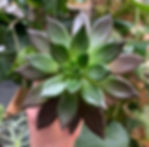How to Look After Echeveria - A Succulents Care Guide
- Sam Gaunt
- Mar 11, 2022
- 4 min read
Here's some tips on how to care for your Echeveria, so that you can make the most of this genus's diverse range of succulent species

Echeveria
The Echeveria genus is a comprised of a vast array of species in the family Crassulaceae.
Native to Mexico and North Western South America. Echeveria spp. present a wide range of choice in terms of colour and style. They're also a relatively easy succulent to care for too, provided you follow some simple rules. This makes them great for beginners, collectors and for making succulent arrangements too.

Light
Like lots of other succulents, Echeveria require lots of light to be at their best. You should aim for at least 6 hours of bright sunlight per day as a minimum. A bright space on a windowsill or somewhere with direct light is perfect.
Shape is a good indicator of if your Echeveria is getting enough light; if it's growing elongated and 'leggy' or towards the light source in a particular direction, it's probably not getting enough light. Giving your Echeveria sufficient light will help it grow its iconic compact and symmetrical rosettes.
Echeveria are capable of growing in direct sun and outside, just make sure it's not too cold. If you have a new or juvenile plant, you might want to give it time to adjust and acclimatise to the outdoors first, starting in a bright window and gradually increasing outdoor /direct sun exposure.

Soil
The number one quality to aim for in your Echeveria's soil is drainage. A loose, well draining soil is what you need.
We like to add a good amount of perlite, a bit of coarse sand and some diatomaceous earth into our soil mix to help with drainage, vary particulate size and keep pests at bay. You can buy premade cacti and succulent potting mixes which should work fine too.
Avoid overly peaty / coconut husky soil that will compact over time, smother your Echeveria's delicate roots and eventually become hydrophobic.

Watering
The main problem you'll have with Echeveria is overwatering, so always err on the side of caution. Echeveria are succulents and can survive periods of drought.
Only water your Echeveria when the soil has completely dried out. You'll need to water it slightly more regularly (every 1-2 weeks, depending on climate) in the warmer months and a lot less in the colder months.
When watering, you can give an Echeveria with a fully developed root system a good soak until the water comes out the drainage holes in the bottom of the pot. Empty any excess water that drains out, you don't want your Echeveria to sit in it.
Try to avoid getting water on the plant'. Water droplets that accumulate on an Echeverias waxy leaves will act like a magnifier in bright sunlight and burn the plant.
Pick your pot up when it's dry and again after watering and notice the weight difference, this is a good way to tell when a plant needs watering. It it's airy light, you're good to give it a drink. Echeveria's leaves are also a good sign for when to water; if they're shiny and plump, they're full of liquid, if they're starting to go thin and slightly wrinkled (and your soil is dry) a good water will see them spring back to life.

Humidity
Echeveria are native to dry, semi-desert areas and don't require humid environments. You don't need to mist your Echeveria houseplant at all. Creating a too wet or humid environment around your succulents will encourage pests and water on the plant's leaves can act as a magnifier and scorch the plant in full sun.

Temperature
Average household temperature is fine for your Echeveria, though they don't mind it being warmer (they're from Mexico and South America remember).
When growing outside, if you live in an area that gets cold in the winter, you'll want to bring your plant inside. Leaving it out in the cold and rain will cause the plant to perish and rot.
Avoid frost at all costs and aim for temperatures between 10-21°C.

Toxicity
Echeveria plants are a non toxic succulent variety, safe for humans and pets. Though we'd still recommend keeping them away from prying paws so that their beautiful rosettes remain symmetrical and intact!

Growth
Echeveria have a huge breadth of colourful and compact growing species to choose from, making them great for planting in mixed succulent containers. You don't need too deep a pot either, just something that will drain freely.
If you want to encourage your Echeveria to flower, letting the plant go dormant is a good idea, for most species dormancy is in winter. In dormancy, when daily light is less and drought more regular, your Echeveria will slow its growth. In winter/dormancy you can just let your Echeveria be and only water when they really need it. When you up the watering again in summer, you'll be rewarded with enthusiastic growth and hopefully flowering too!
Echeveria will grow pups from around the mother plant which can easily be propagated. You can also propagate from leaf cuttings too; remove a leaf as close to the stem as possible, let it callous over for a few days and sit it on some soil until roots start to form and watch as your Echeveria family grows!